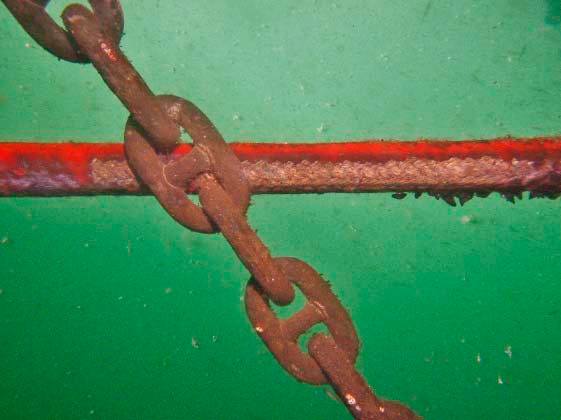Underwater lines that anchor the new South Whidbey Harbor marina floats in place are rubbing and beginning to show signs of chafing.
And according to the Port of South Whidbey, it’s because they were installed incorrectly.
Port officials have asked Friday Harbor-based Mike Carlson Enterprises, Inc., to fix the problem. Responsibility may be a matter of debate, however, as the firm indicated in recent correspondence to port attorneys that the work was done as specified and approved.
Who will pay for the fix also remains unclear. In the correspondence, the contractor agreed the situation should be remedied, but the letter did not make clear whether the bill would be covered under the contract’s warranty, which is for a period of one year, according to the port’s law firm, Everett-based Anderson Hunter Law Firm.
“The position of the port is that the work to rectify the alignment of the lines, the damage to the poly line and chains, as well as the lack of properly positioned high density polyethylene sleeves is all warranty work, the remedy for which is that the work is properly brought into consistency with the contract specifications,” wrote Bradford Cattle, of Everett-based Anderson Hunter Law Firm.
Mike Carlson declined requests for comment.
The $1.7 million project added about 330 feet of new dock space to the existing marina and was officially completed in April 2014. The problem with the anchoring lines was discovered in September when the port, working on another dock project, had the facility surveyed by Seattle-based Collins Engineers, Inc.
The firm’s structural condition assessment report determined the general condition of the facility to be “good” and “satisfactory,” but did find five anchor lines that secure the new docks “D” and “E” to the seafloor to have “varying degrees of abrasion and coating damage.” The lines are designed to extend in a crisscross fashion and were found to be rubbing against each other.
Some of the problem lines are chain and had galvanization — a layer of zinc used to protect steel in marine environments — rubbed off, and others were synthetic materials that also had abrasion damage.
They were listed in the report as priority one deficiencies that are “recommended to be repaired within 12 months.”
Fixes included installing low friction protective barrier coats at chain-to-rope abrasion areas, and to evaluate solutions for metal-to-metal contact abrasion areas.
According to port officials, the problem is the result of the crisscrossing lines being installed in the wrong order. They maintain that makes the contractor responsible for setting the matter right.
“To me, it’s a warranty issue; it’s real simple,” said Commissioner Curt Gordon, chairman of the board.
“They just need to fix it,” he added.
The actual installation of the lines was performed by Neptune Marine, a subcontractor for Mike Carlson Enterprises. The company contends the work was done right, according to a Dec. 30 letter sent to port attorneys.
“We have proof it was installed correctly and we have provided the port with such proof that the work was done properly and inspected as correct,” the letter stated.
The letter was sent by Mike Carlson, president of Carlson Enterprises, but quoted provided correspondence by an unnamed Neptune official. That representative went on to suggest a course of fixing the problems, and said the work could have been done by January.
Port attorneys, however, maintained it was unclear whether the companies would cover the work under warranty. The entities have since agreed to meet with a third-party mediator to address the issue.
Port Executive Director Angi Mozer said she was optimistic a solution would be identified at the meeting, that litigation could be avoided.
“It’s sounds like everyone is being reasonable so I think it will be solved through mediation,” she said.
The port may want one line to be replaced, not just reinstalled, and plans are in place to do another underwater inspection soon.
“It’s been a couple of months,” Mozer said. “We just want to make sure everything is OK down there.”
A meeting date has not yet been set.



